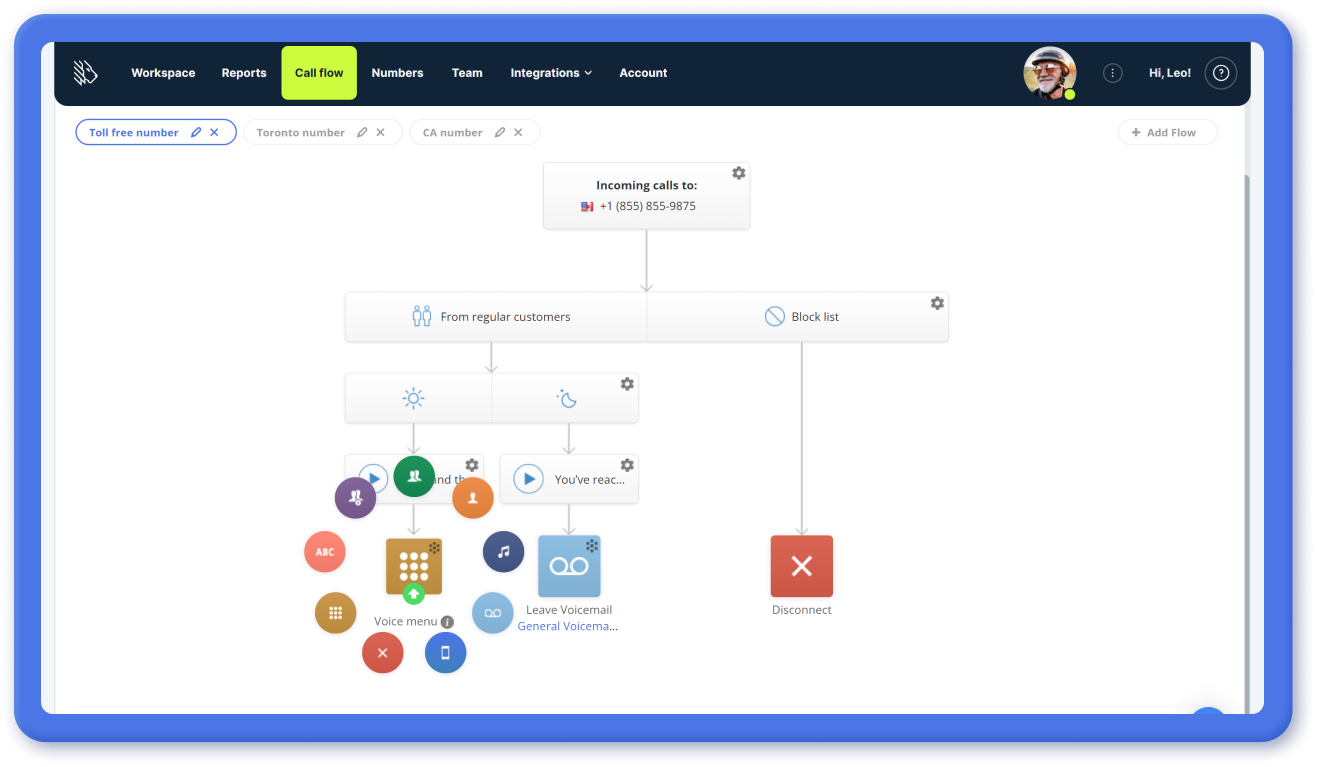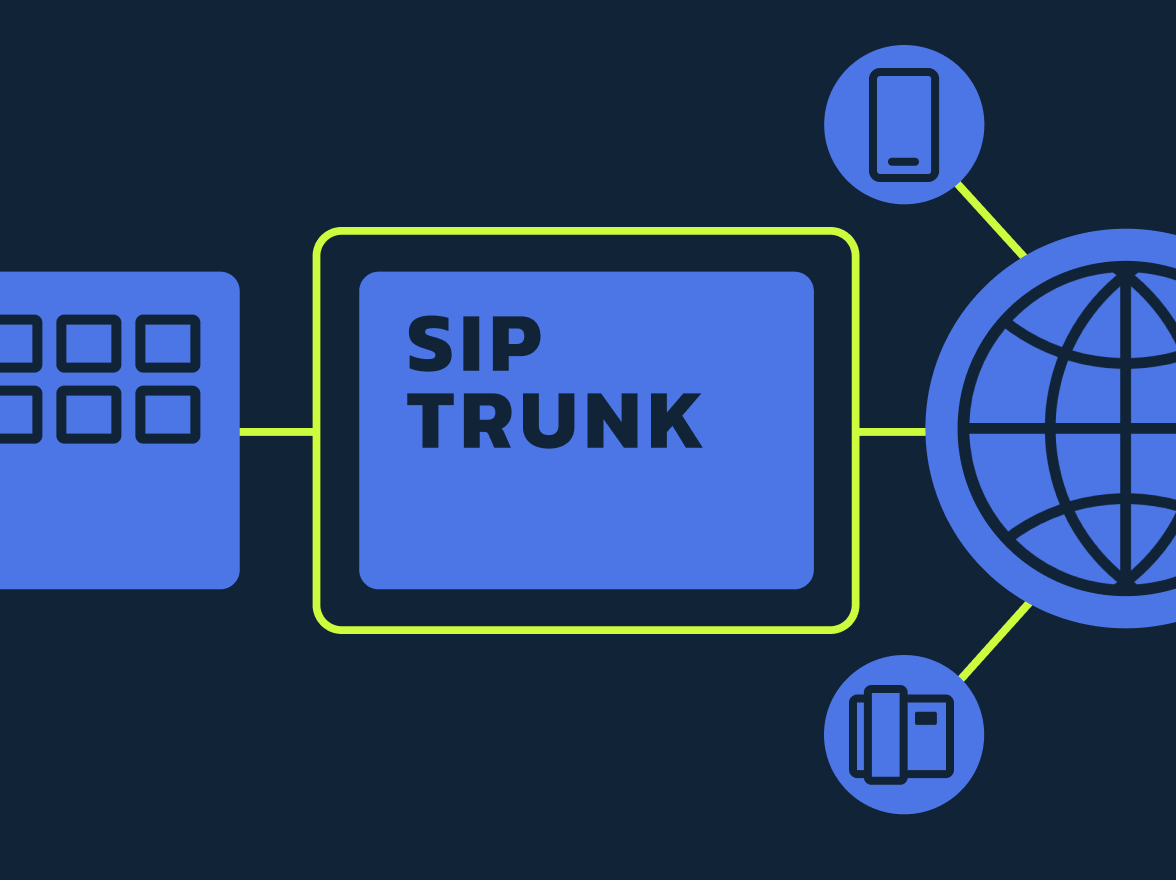What is a SIP trunk? Do you need it? What are its operational mechanics and the benefits it brings to the table? Whether you’re transitioning from traditional phone systems or looking to improve your existing VoIP setup, understanding SIP lines as an option is crucial.
Join us as we explore how this technology can improve functionality, scalability, and budgeting in your business communication strategies.
- What is SIP trunking?
- How does SIP trunking work?
- What is required for SIP trunking?
- What is SIP trunking used for?
- How can MightyCall help with SIP trunks?
- SIP trunking vs. PRI
- What is the difference between VoIP and SIP trunk?
- Benefits of SIP trunking
- Are there any disadvantages?
- The evolution of SIP trunking
- What to consider while choosing SIP trunking service
- What are the best features to look for in a SIP trunking service
- Starting with the SIP trunk service
- Making the most of SIP trunking
What is SIP trunking?
SIP trunking is a method of delivering telephone and other communication services over the internet using the Session Initiation Protocol (SIP). It replaces traditional analog phone lines, connecting the private branch exchange (PBX) to the internet.
In essence, SIP trunking allows for the transmission of voice calls and other forms of multimedia communication, including video and text, over an IP network. It offers businesses a functional and affordable way to scale their communication capabilities without the need for physical hardware or phone lines.
How does SIP trunking work?
Connection to IP network
Trunking begins by connecting a company’s Private Branch Exchange (PBX) system to the internet using the SIP. This protocol is crucial for transferring communication data over the internet, linking traditional telephony systems with digital communication.
Voice and data conversion
Once the connection is established, voice signals are converted into digital data packets for transmission over the IP network. This protocol plays a vital role in this conversion process, managing the digital pathways needed for internet-based voice calls.
Handling multiple channels
A significant feature of SIP trunk is its ability to handle multiple voice channels through a single trunk. This means multiple calls can be conducted concurrently, making clear the advantage of the system over traditional phone lines.
Dynamic call routing
With some providers, how SIP trunking works is by dynamically routing calls to and from the PBX system. This involves determining the best path for each call based on pre-defined rules, such as caller ID or dialed number, ensuring effective call handling.
Session management and termination
Trunking manages the entire lifecycle of each call session. This includes establishing the call, maintaining the connection during the conversation, and then properly terminating the session once the call is completed.
Monitoring and managing bandwidth
An essential part of trunking involves monitoring and managing the bandwidth usage. This ensures optimal call quality and prevents network congestion, especially during peak hours or high call volumes, maintaining consistent communication quality. Through these steps, trunking successfully transforms traditional phone systems into more scalable and versatile communication networks, suitable for the modern digital business environment.
What is required for SIP trunking?
Once you have decided to use SIP trunking, you will want to get a few things ready:
- A reliable internet connection with adequate bandwidth of at least 110 Kbps, the faster, the better for telephony.
- SIP and VoIP-compatible PBX system.
- Compatible handsets or headsets if used, or a regular device that connects to the internet and has an input and output for audio.
- A VoIP gateway for businesses using legacy equipment.
- A SIP trunk platform to establish and manage the service.
What is SIP trunking used for?
SIP trunking defines a significant leap in business telecom, replacing traditional PRI lines with a more functional affordable solution. It enables the simultaneous transmission of multiple voice calls over a single connection, optimizing communication capacity. This technology not only reduces the need for physical phone lines but also cuts operational costs by leveraging existing IP networks. Its scalable nature suits businesses experiencing growth or varying call volumes.
Additionally, this calling format supports diverse multimedia services, expanding upon communication capabilities. This flexible and scalable solution is ideal for modernizing business communication infrastructures, offering a blend of functionality, cost savings, and advanced features.
How can MightyCall help with SIP trunks?
MightyCall takes a thorough approach to trunking, offering solutions for dynamic business needs:
- Simple integration: Integrates with your existing systems, ensuring a smooth transition.
- Customizable call routing: Create your call flow with smart routing options, adapting to customer patterns and business hours.

- Enhanced features: Enjoy advanced telephony functions like call forwarding, voicemail, conferencing, and call monitoring.
- Reliable & secure: Benefit from security and consistent call quality, ensuring uninterrupted communication circuit.
- Personalized support: Get a personal demo-session and contact support 7 days a week ensuring your Session Initiation Protocol trunking setup aligns perfectly with your business strategy.
SIP trunking vs. PRI
| Features | SIP trunking | PRI |
|---|---|---|
| Value for money’s worth | More cost-effective due to reduced physical infrastructure needs and maintenance costs. | Higher prices associated with physical lines and hardware maintenance. |
| Scalability and flexibility | Easily scalable; can add or remove lines without physical changes. | Limited scalability; physical lines must be installed or removed. |
| Technology integration | Integration with modern VoIP and unified communication systems. | Limited integration; primarily supports traditional voice communication. |
| Reliability and continuity | Higher reliability with options for call rerouting during network issues. | Relies on physical lines, susceptible to local disruptions. |
| Global connectivity | Facilitates global reach with the ability to establish local presence. | Geographical limitations; international setup often required. |
| Eco-friendly approach | Reduces environmental impact by minimizing physical infrastructure. | More resource-intensive with a higher environmental footprint. |
| Bandwidth utilization | Functional bandwidth use allows for better quality and more calls over the same SIP connection. | Limited by the physical line capacity, often resulting in underutilized bandwidth. |
| Multi-functionality | Supports voice, video, and data over the same connection, enhancing versatility. | Primarily voice-focused, with limited multi-functional capabilities. |
| Installation and maintenance | Easier and quicker to install and maintain, with less dependency on physical infrastructure. | Requires physical installation and ongoing maintenance, often leading to longer setup times. |
| Future-proofing | Better suited to adapt to future technological advancements in telecom. | Traditional setups are potentially becoming outdated as technology advances. |
While PRI trunking has been a reliable choice for traditional voice communication, switching to SIP trunking offers greater cost savings, scalability, and technological integration. Its advantages in global connectivity and eco-friendliness make it a more versatile and future-proof solution for modern businesses.
What is the difference between VoIP and SIP trunk?
SIP or VoIP? VoIP (Voice over Internet Protocol) and Session Initiation Protocol (SIP) trunking are often mentioned together in the context of modern telephony, but they serve different functions.
VoIP is a broad technology category that describes the method of transmitting voice calls over the internet instead of traditional phone lines. It encompasses a wide range of internet-based communication services, including voice calls.
The function of SIP trunks, on the other hand, lies in a specific method used to enable VoIP technology. It acts as a virtual version of a traditional phone line, using the SIP standard to facilitate the connection of a private branch exchange (PBX) to the internet. This technology with the right operator allows for the transmission of voice, video, and other forms of multimedia communication over the internet. In essence, while VoIP refers to the general concept of internet-based communication, SIP trunk service allows businesses to connect their existing phone systems to a VoIP network.
Benefits of SIP trunking
Direct Inward Dialing (DID)
SIP trunk phone systems enable Direct Inward Dialing, allowing businesses to assign unique phone numbers to individual employees or departments without requiring multiple physical phone lines.
Enhanced network utilization
It optimizes network utilization by allowing the transmission of voice and data over the same connection, reducing the need for separate networks and improving overall communication.
Dynamic bandwidth allocation
SIP trunking systems dynamically allocate bandwidth based on need, ensuring optimal use of available resources for both voice and data transmission.
Multi-site integration
Facilitates the integration of communication systems across multiple business locations, creating a unified network that simplifies internal and external communications.
High compatibility with legacy systems
SIP protocol can be integrated with existing legacy telephony systems, providing an affordable way to upgrade communication capabilities without a complete infrastructure overhaul.
Regulatory compliance support
Many SIP trunking services offer features that help businesses comply with industry regulations, such as call recording and secure data handling, which are essential in certain sectors.
KPI tracking
SIP trunking improves key performance indicators for businesses by providing detailed call analytics, aiding in monitoring, and enhancing crucial metrics such as call handling time and customer satisfaction.
Reduced carbon emissions with virtual meetings
Supporting high-quality voice and video conferencing, trunking encourages virtual meetings, reducing travel-related carbon emissions, and supporting sustainable business practices. This approach also lessens dependence on physical hardware and paper-based systems.
Are there any disadvantages?
Dependence on internet quality
SIP line performance heavily relies on internet quality; poor connectivity can lead to communication issues.
Security concerns
Without proper security measures, SIP trunks can be vulnerable to cyber threats like hacking and eavesdropping.
Technical expertise
Implementing and managing SIP channels may require more technical expertise compared to traditional phone systems.
Complexity in configuration
Configuring trunks can be complex, especially in systems with multiple lines and varied features, requiring detailed setup and ongoing maintenance, which can be resolved with the help of a provider.
Compatibility Iisues
Some older or traditional telephony systems may not be fully compatible with the SIP trunking technology, requiring additional investment in compatible hardware or software solutions.
The evolution of SIP trunking
SIP channels, now a fundamental part of modern communication strategies, have undergone significant transformation since its inception.
Early development
In the late 1990s, the SIP was developed with a vision to revolutionize how multimedia sessions, including voice, video, and messaging, were initiated, modified, and terminated. This period marked the foundation of trunking, laying the groundwork for a new era in communication. It aimed to transcend the limitations of traditional telephony, offering more flexibility and integration capabilities.
Broad adoption
The early 2000s marked a turning point for trunking. Businesses began to recognize its potential as a more affordable and versatile alternative to conventional PRI (Primary Rate Interface) lines of the landlines. This period saw an increasing number of companies adopting trunking to leverage its benefits, including reduced costs, greater scalability, and improved efficiency in managing voice and data.
Technological advancements
The 2010s were pivotal for trunking, driven by rapid advancements in internet technology and the widespread adoption of VoIP (Voice over Internet Protocol). These developments significantly enhanced the reliability and feature set of trunking, enabling better call quality, strong security measures, and integration with various digital communication platforms. This era also witnessed the expansion of SIP into more sophisticated areas, such as unified communications, which further solidified its position in the market.
Current trends
Today, SIP trunking is an integral component of business communication strategies. It offers a perfect blend of great pricing, scalability, and advanced communication capabilities, addressing the diverse needs of modern businesses. The current landscape sees trunking not just as a voice communication tool but as a useful solution simplifying multimedia communication, collaboration, and customer engagement. Its adaptability and compatibility with emerging technologies suggest a promising future, positioning trunking as a vital technology in the evolving digital world.
What to consider while choosing SIP trunking service
Service quality and reliability
Examine the SIP provider’s track record for service quality and reliability. Look for high uptime guarantees and Service Level Agreements (SLAs) that ensure consistent performance. Check for redundancy features that can keep your service running in case of network failures.
Quality of Service (QoS) Settings
Quality of Service is essential for prioritizing voice traffic over other network uses to maintain call clarity and prevent delays or drops in your business phone system. Ensure the provider can offer superior QoS to support high-quality voice calls even during peak traffic periods.
Scalability and flexibility
Your chosen provider should offer scalability that aligns with your business’s growth. Look for services that enable you to easily add or reduce capacity, depending on your evolving needs, without incurring significant additional costs or technical challenges.
Security and compliance
Evaluate the security measures in place, including data encryption and protection against fraud and hacking. Additionally, the service should comply with industry regulations, such as HIPAA for healthcare or GDPR for European data.
Compatibility with existing infrastructure
Ensure the SIP trunking architecture is compatible with your existing telephony systems and equipment. This includes checking for any necessary upgrades or adjustments to your current setup, like PBX or VoIP gateways.
Pricing structure and cost-efficiency
Compare pricing models among different providers. Look for transparent billing without hidden fees. Consider the total cost of ownership, including setup, maintenance, and potential upgrade costs. A service should offer competitive rates and clear, straightforward billing practices.
Customer support and service
Effective customer support is vital. A reliable provider should offer accessible support, including technical assistance, customer service, and troubleshooting capabilities. Check for 24/7 support options, especially if your business operates across different time zones.
Network infrastructure
Assess the provider’s network infrastructure, for international or local phones, depending on your needs. A strong and widespread network can ensure better call quality and reliability. Enquire about the geographical locations of their data centers and their ability to handle high call volumes.
Trial period and testing
A trial period allows you to evaluate the service’s performance in real-world conditions. Opt for providers who offer a no-obligation trial period, giving you the chance to test call quality, reliability, and customer support.
What are the best features to look for in a SIP trunking service
When selecting a SIP trunking provider, certain features stand out as essential for effective business communication. Here’s a list of features to consider:
- Call log: Maintaining a detailed log of all inbound and outbound calls is essential for tracking and analysis purposes, helping businesses monitor call activities and identify trends, especially when dealing with multiple trunks and a large call volume.
- SMS and MMS capabilities: Look for SIP phone services that enable engagement with customers through text, including SMS and MMS, allowing for a broader range of communication, including text, images, and videos.
- Call waiting: Ensures that incoming calls are attended to even when the line is busy, allowing businesses to manage multiple calls without missing important connections.
- Call flow designer: A call flow designer feature allows for the customization of call handling processes. It provides a visual interface to design and implement call routing paths, IVR menus, and specific instructions based on time, date, caller ID, and other variables. This tool is essential for businesses looking to set up their phone system to manage large call volumes.
- Automatic call distribution: This feature intelligently routes incoming calls to the appropriate department or agent based on predefined criteria, freeing the valuable time of operators and decreasing the response time.
- Call Management Tools: Advanced call management features such as call routing, IVR (Interactive Voice Response), call queues, and call transfer (both warm and cold) are vital for call handling.
- Call analytics and monitoring: Features such as live call monitoring, call recording, and real-time analytics are essential for managing call center performance and improving customer service.
- Integration with business tools: Integration capabilities with popular business tools like Salesforce, HubSpot, Zoho and Zapier can significantly enhance workflow success.
- User and team management: Look for services offering user and team management features, including user extensions, roles & permissions, and agent workspace options.
- Advanced call features: Additional features like voicemail to email and text, custom greetings, and call notes can greatly upgrade the overall functionality and user experience of the service.
Starting with the SIP trunk service
Starting to implement SIP trunks is a strategic move towards advanced business communication. Here’s a guide to help you navigate the process, structured in two parts: what to consider before implementation and steps to follow afterwards.
Pre-implementation considerations:
Evaluate network capacity:
- Ensure your current internet bandwidth can support SIP traffic.
- Check the stretch of your network infrastructure for compatibility.
Assess equipment compatibility:
- Verify if existing PBX or phone systems are SIP-enabled or if a VoIP gateway is required.
- Consider upgrading hardware to upgrade your voice transmission quality.
Select your SIP trunk provider:
- Research providers based on reliability, cost, features, and customer support.
- Prefer providers who offer a trial period for the initial assessment.
Post-selection setup and configuration:
Configure the PBX system:
- Set up your PBX for connectivity using the details provided by your service provider.
Establish call management settings:
- Implement call routing, IVR, and call queue structures based on business needs.
- Activate essential features like voicemail, call forwarding, and recording.
Test for errors:
- Test for call quality, feature functionality, and system reliability.
- Train staff on the new system and its features.
Ongoing monitoring and adjustments:
- Regularly review system performance and usage statistics.
- Maintain communication with your SIP provider for any necessary adjustments or updates.
Making the most of SIP trunking
Trunking is a strong solution for modern businesses, blending good pricing, scalability, and advanced technological integration. Its ability to adapt to diverse communication needs while ensuring high-quality, reliable service makes so popular in today’s digital landscape. Embracing SIP trunk means stepping into a realm of strong connectivity and successful operations, made for the demands of your business.
MightyCall improves this experience by offering customized solutions that align with your specific business requirements. With our commitment and continuous support, we ensure that your journey into calling is both pleasant and simple, driving your business towards new heights of communication.























